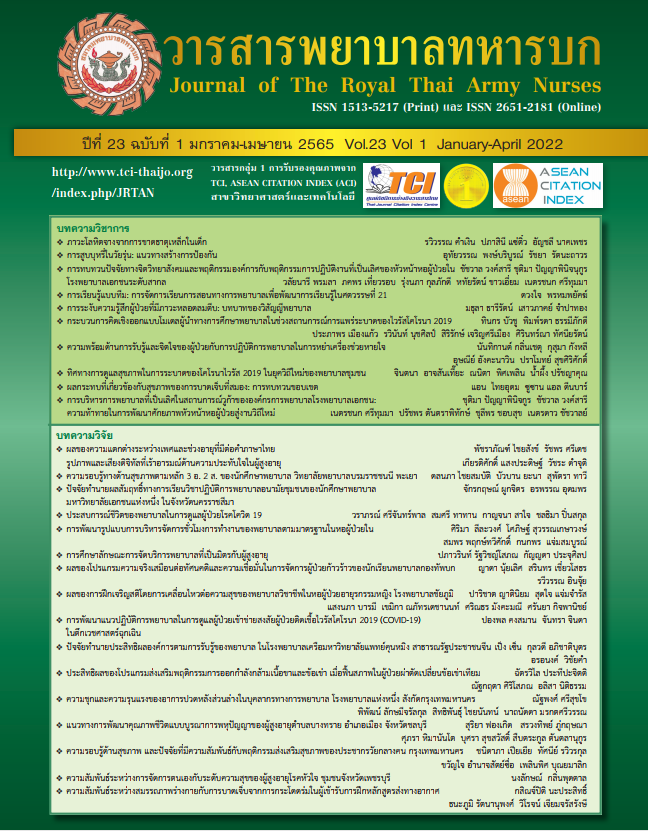A Study of the Feasibility of Clinical Nursing Practice Guidelines for Assessment and Prevention of Acute Kidney Injury in Critical Surgical Patients
Abstract
This developmental research design aims to develop clinical nursing practice guidelines (CNPG) for the assessment and prevention of acute kidney injuries (AKI) among critical surgical patients and studying feasibility, satisfaction, and outcomes by implementing the aforementioned practice guidelines. The Soukup model was used as a conceptual framework for developing the practice guidelines which consists of 2 phase: 1) guideline establishment and 2) implementation and study the outcomes. The samples of phase 1 were empirical evidence based on PICO research criteria, amount 21 subjects. The purposive sampling method was used to select samples of phase 2 which were 35 professional nurses working in the Surgical Intensive Care Unit, and 220 surgical critical patients who were treated in the Surgical Intensive Care Unit. Data were collected using a set of questionnaires and analyzed using descriptive statistics.
The results revealed that the CNPG for the assessment and prevention of AKI among critical surgical patients consisted of diagnostic criteria using KDIGO criteria, risk assessment for 3 steps and 10 items of CNPG in preventing AKI The overall feasibility after implementing the CNPG was found to be high (Mean = 3.68, S.D. = 0.57). Nurses had a high level of satisfaction (Mean = 3.83, S.D. = 0.59). The prevalence of acute kidney injury in patients was 23-26 percent, which has a tendency to decrease.
Downloads
References
Harty J. Prevention and Management of Acute Kidney Injury. The Ulster medical journal. 2014; 83(3): 149-57.
Bhumibol Adulyadej Hospital. Department of Medical records and statistics. Statistics of patients with acute renal injury in Surgery Intensive care unit. Bangkok: 2014. (in Thai)
Kidney Disease Improving Global Outcome (KDIGO). KDIGO clinical practice guideline for acute kidney injury. Kidney Int Suppl 2012; 2: 1-138.
Ponce D, Zorzenon CDPF, Santos NYD, Balbi AL. Early nephrology consultation can have an impact on outcome of acute kidney injury patients. Nephrology Dialysis Transplantation. 2011; 26(10): 3202-6.
Finlay S, Bray B, Lewington AJ, Hunter-Rowe CT, Banerjee A, Atkinson JM, et al. Identification of risk factors associated with acute kidney injury in patients admitted to acute medical units. Clinical Medicine. 2013; 13(3): 233-8.
Siriluk Thungtong. Delayed Progression Diabetic Nephropathy in Patients with Uncontrolled Type 2 Diabetes Mellitus. Journal of The Royal Thai Army Nurses. 2017; 18(2): 17-24. (in Thai)
Lee JE. Increased intra-abdominal pressure in acute kidney injury: a cause or an effect? Kidney Res Clin Pract 2015; 34: 67-78.
Martin-Moreno PL, Varo N, Martínez-Ansó E, Martin-Calvo N, Sayón-Orea C, Bilbao JI, et al.Comparison of Intravenous and Oral Hydration in the Prevention of ContrastInduced Acute Kidney Injury in Low-Risk Patients: A Randomized Trial. Nephron. 2015; 131(1): 51-8.
Wongsaree C, Praneetham W. The study of Relationship and Factors influencing of Dietaryand Fluid Consumption among End Stage Renal Disease Patient Receiving Hemodialysis. Journal of The Royal Thai Army Nurses. 2019; 19(3): 117-25. (in Thai)
Forde C, McCaughan J, Leonard N. Acute kidney injury: It’s as easy as ABCDE. BMJ quality improvement reports. 2012; 1(1), u200370- w326.
Soukup SM. The center for advanced nursing practice evidence-based practice model. Nursing Clinics of North America. 2000; 35(2): 301-9.
Khiewchaum R. Evidence-based Nursing. Journal of Phrapokkao Nursing College, 2013; 24(2): 94-108. (in Thai)
Polit DF, Beck T. Essentials of Nursing Research: Appraising Evidence for Nursing Practice 8th ed.Philadelphia: Lippincott; 2014.
Poolaireab P, Danaidutsadeekul S, Chanruangvanich W. The relationships among comorbidity, intraoperative conditions, systemic inflammatory response syndrome, and acute kidney injury of critical patients in first 72 hours after major surgery. J Nurs Sci. 2016; 34(1), 107-17. (in Thai)
Wallace K, Mallard AS, Stratton JD, Johnston PA, Dickinson S, Parry RG. Use of an electronic alert to identify patients with acute kidney injury. Clinical Medicine. 2014; 14(1), 22-6.
Podoll AS, Kozar R, Holocomb JB, Finkel KW. Incident and outcome of early acute kidney injury in critically-ill trauma patients. PLoS One. E77376. 2013.
Bunsut P. Effects of clinical nursing practice guideline development for acute kidney injury patients with continuous renal replacement therapy in intensive care unit. Journal of nursing association of Thailand, North-eastern division. 2011; 29(4): 50-7. (in Thai)
Downloads
Published
How to Cite
Issue
Section
License
Copyright (c) 2022 Journal of The Royal Thai Army Nurses

This work is licensed under a Creative Commons Attribution-NonCommercial-NoDerivatives 4.0 International License.
บทความหรือข้อคิดเห็นใดใดที่ปรากฏในวารสารพยาบาลทหารบกเป็นวรรณกรรมของผู้เขียน ซึ่งบรรณาธิการหรือสมาคมพยาบาลทหารบก ไม่จำเป็นต้องเห็นด้วย
บทความที่ได้รับการตีพิมพ์เป็นลิขสิทธิ์ของวารสารพยาบาลทหารบก
The ideas and opinions expressed in the Journal of The Royal Thai Army Nurses are those of the authors and not necessarily those
of the editor or Royal Thai Army Nurses Association.






